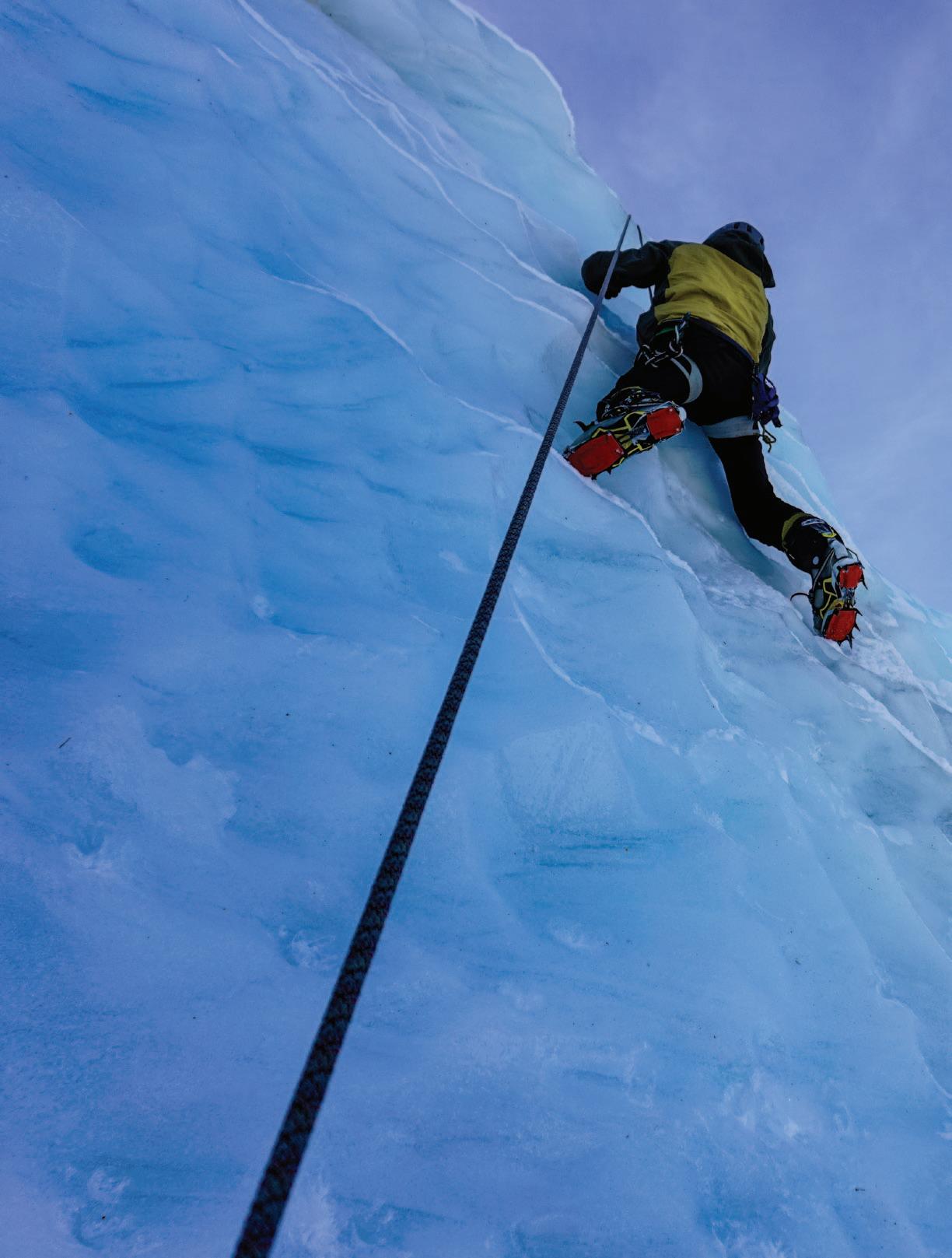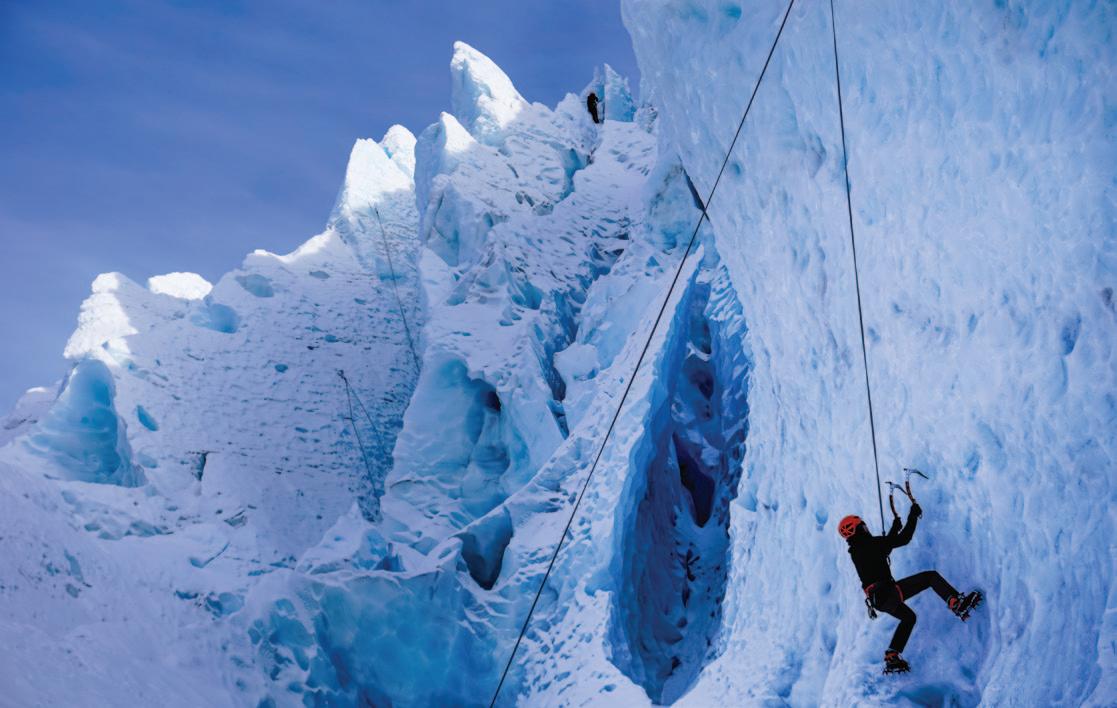
5 minute read
The Cold Shoulder
Story and Photos by Nick Belcaster
The gold Grand Marquis in the ditch was probably a sign.
But that was a mile or so back now. Driving up Forest Road 39 has become a death-defying experience. The higher we go, the more the road surface devolves, glazed over in a sheen of glare ice. The first snow of the season has turned against us. I’m joined by the only partner I could cajole, lie to or otherwise hijack into accompanying me on my pursuit of just one last climbing trip straight in the thick of the transition from fall to winter.
Now, we’re considering how we’re even going to get back down in one piece.
“Yeah, it’s a shit-show up there. We’re outta here.” When the man in the Jeep with 37 inch tires tells you this, it’s time to tuck tail. I manage to get the car turned around and into first gear, slowly lumbering downhill, only losing control a handful of adrenal-squeezing times.
We agree to reconvene in one week’s time, hoping for another fleeting weather window and less Crisco-like pavement.
The shoulder season does not avail itself to our entreaties easily.

Seasons balanced on the razors edge. The first snow of winter contrasts with the deep blue of the summers exposed ice.
Whenever I tell people about Western Washington, it’s bound to come up. The rain. Rains a lot up there, huh? Like we’re semi-aquatic–vestigial gills and all. Moss behind our ears.
I like to think it’s a bit more nuanced than that, that we have a specific rainy season, independent from the general drizzle. Wherein our handshake agreement with the Weather Gods allows for the loan of sunshine to be paid back as a lump sum, sometime between October and November. This is the shoulder sea- son. An interlude for eternally optimistic outdoor recreationalists.
Too cold to climb rock, not yet snowy enough to ski, and just about miserable enough to make backpacking a less-than-ideal affair, the shoulder season is typically the time for reflection or planning, gear repair or purchase. For general repose. The rain falls in dark sails, luffing and snapping on shore. Most find a new hobby. Some are too foolhardy to stop what they’ve been doing.
This time of year is typically a slow time at the mountaineering shop where I’ve somehow convinced the owner to actually pay me to fiddle with expensive gear all day. Once September rolls around and the gloss of the high season fades, we settle into a milder rhythm. The Sprinter van-types beat it to Vegas, but not us. We coil ropes and check for core shots. Drink beers at 3 p.m. The rain thrums the windows.
On one such afternoon I am here in the shop, scrubbing the late-summer pumice mud from the lugs of mountaineering boots, when the realization comes to me: I don’t know what I’m doing next weekend. So I inquire around for ideas. One of my co-workers is going to try his luck skiing Heliotrope Ridge. Another may sneak in some running if this rain lets up. We pore over potential scenarios for multi-sport days: a ski in the morning and a paddle by afternoon, mountain biking to a bouldering spot. Anything goes with enough Gore-Tex and gumption.
I grab another pair of boots, feeling strangely invigorated, pondering how the coming together of the seasons might offer some fresh facet of being outside, some new mix of challenge and reward unknown in the heights of summer or the depths of winter.
Then, there are the realists. Later I ask another coworker what he liked to get into during these months. The answer, without much thought:
“Soup, mostly.”
Finally, it arrives.
High pressure. Clear skies. Warm enough. Any desperate man or woman with the day off or a good enough excuse finds themselves headed for the hills. Some run or bike through the muck, the ‘Turns All Year’ folks are off skiing dirty smears of snow, and others, like us, head for the permanent exposed ice of our local volcano.
Back on Forest Road 39. This time the road is free and clear (Grand Marquis is still there) and we pull into the trailhead with ease. There’s a snap to the air as we pack away all the necessary seasonal accoutrements: thermoses of hot drinks, gloves, bigger gloves, microspikes, trekking poles with powder baskets, hell, one more pair of gloves. Then we turn onto the dark of the Heliotrope Ridge trail and begin climbing.

From swinging your ice tools for the first time to getting overhung, Koma Kulshan has ice for everyone.
The tread begins on dark loam but is quickly speckled in white. There is something about the first snow, the way it lays on the land, both concealing and accentuating the familiar contours.
The rumbling glacial torrents that cross the trail and swell in summer’s heat are now tamed but unyielding, fringed around the rocks with a crystalline lattice of ice. For some reason the forest’s scent is especially sweet today. We climb through seasons, ascending from autumn to winter, reaching the small turnoff that leads down to Mirkwood Camp, a scattering of sites perched on the lateral moraine above the Coleman glacier. After descending the moraine we poke our way out onto the crumpled edge of the ice, donning crampons. The glacier here is studded with rock from the steady ablation of ice, once a long snowy finger that has melted back to the knuckle. I am surprised to count off the number of climbers already on the glacier, their ropes spanning multiple tiers of ice.
I ramble up, finding an adequate face and fire a few ice screws into the ancient blue, equalize, toss down rope, rappel. We take turns making laps up the ice, swinging our tools, kicking our toes, each sending a spray of ice. Swing, swing. Kick, kick.

A climber challenges himself on a cresting wave of ice on the Lower Coleman Glacier.
We talk about the long-lost summer and the passing of autumn. We talk about the winter opening around us. But mostly we talk about being here, now.
Eventually with arms burning and legs wobbly, pant legs sporting a few new crampon gashes and our rope turning icy, we pause to watch the other climbers. Many are trying ice climbing for the first time, and they work through the movements with encouragement from below. The clouds part and the fresh snow on the mountains around us gleams in the sun. The ice moves imperceptibly beneath us. The wheel never stops turning.
Joy abounds in the margins, in the in-between of this shoulder season.
Swing, swing. Kick, kick. Here, now.






